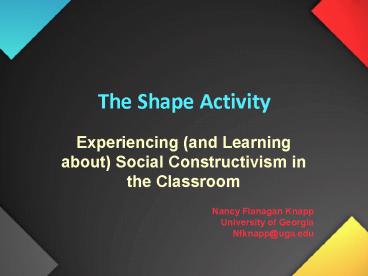The Shape Activity - PowerPoint PPT Presentation
1 / 5
Title:
The Shape Activity
Description:
What characteristics were most salient or important in your ... Through conversation, a group can construct what that no single ... PowerPoint Presentation Author: – PowerPoint PPT presentation
Number of Views:53
Avg rating:3.0/5.0
Title: The Shape Activity
1
The Shape Activity
- Experiencing (and Learning about) Social
Constructivism in the Classroom - Nancy Flanagan Knapp
- University of Georgia
- Nfknapp_at_uga.edu
2
The Shape Activity
- Please take the next 15-20 minutes to work with
your small group, following the directions on
your envelope (other groups have different
directions).
3
When you are through, discuss be prepared to
share...
- 1. Explain how your group decided to organize/use
the pieces you were given. - 2. What characteristics were most salient or
important in your decisions on how to place/use
each piece? Why were these characteristics most
important? - 3. Did everyone agree right away about how to
organize/use the pieces? - a) If not, what alternatives were suggested? How
did you come to agree on your final plan? Did
different group members take different roles in
this process? - b) If so, can you think of any other reasonable
way(s) to organize/use these pieces?
4
Some SC ideas . . .
- 1. People's purposes influence constructions.
- 2. People will interpret identical instructions
differently, due to prior experiences and
background knowledge. - 3. The characteristics of the materials
given/available influence possible constructions. - 4. The understood purpose of construction
determines what characteristics matter. - 5. There are often numerous "right"
constructions the same materials can be used in
a variety of ways to achieve the same purpose.
BUT there can also be wrong (ineffective,
harmful) constructions. - 6. Through conversation, a group can construct
what that no single member had previously thought
of the knowledge of the whole group becomes more
than the sum of its parts. - 7. Power relationships (based on gender,
culture, knowledge, temperament) influence final
group constructions.
5
(No Transcript)































